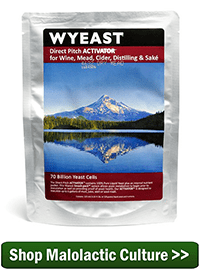 My red wine harvested this year is currently going through a malolactic fermentation, but it has a nutty flavor that has persisted for a month or so. I have never tasted this particular flavor in a wine undergoing malolactic fermentation before. What causes a nutty flavor in wine?
My red wine harvested this year is currently going through a malolactic fermentation, but it has a nutty flavor that has persisted for a month or so. I have never tasted this particular flavor in a wine undergoing malolactic fermentation before. What causes a nutty flavor in wine?
Jack W. – TX
—–
Hello Jack,
A malolactic fermentation can have a light, nutty influence on a wine, but it is typically not noticeable in reds. It is more likely to be a characteristic experienced in whites, more specifically, Chardonnay.
If the your homemade wine has a nutty flavor or taste that is more like hazelnut, I would not be concerned about it too much. It is most likely coming from the malolactic culture. But, if your homemade wine has more of a bitter nut flavor, giving almost a metallic impression, then it could be something called autolysis.
Autolysis is a process that can happen as a fermentation runs out of sugars. The active yeast cell – still looking for food – will begin to consume the dead and inactive yeast cells that lay at the bottom of the fermenter. In doing so, the yeast produce an enzyme that puts off a bitter-nut to metallic flavor. This is the more common reason for having a nutty flavor in wine – particularly, such a young wine.
 The one sure way to keep autolysis from occurring in any wine is by not allowing it to sit on any dead yeast cells for extended periods of time. A few days, or even a couple of weeks is fine in some cases, but neglecting the wine further than this can result in the autolysis process occurring enough to put a nutty flavor in wine.
The one sure way to keep autolysis from occurring in any wine is by not allowing it to sit on any dead yeast cells for extended periods of time. A few days, or even a couple of weeks is fine in some cases, but neglecting the wine further than this can result in the autolysis process occurring enough to put a nutty flavor in wine.
If you have been keeping up with your rackings, then I doubt autolysis is something that should have even brought up here. In this situation the nutty taste is most likely to be all caused by the malolactic fermentation, but if you still have the wine on the sediment from the primary fermentation, then autolysis is a very real possibility.
If after reading this you feel that the nutty flavor or taste in your homemade wine is coming from the MLF, you have a choice. You can allow the MLF to continue, or if you do not like the flavor, you can permanently stop the MLF by adding a dose of sulfite to the wine. A teaspoon of potassium metabisulfite for every 16 gallons will be sufficient. This will keep it from getting any more intense. If you feel the nutty flavor is coming from autolysis, then you will need to rack the wine into a clean vessel, away from the sediment.
Regardless of why there’s a nutty flavor in wine, it is irreversible. I have seen situations where the nuttiness has reduced or mellowed with aging,  but I would not count on it happening. As a benefit, the nuttiness could end up working out to compliment other characters that develop as the wine ages. This would help by promoting the wine’s complexity.
but I would not count on it happening. As a benefit, the nuttiness could end up working out to compliment other characters that develop as the wine ages. This would help by promoting the wine’s complexity.
Jack, I hope this clears up what’s happening to your wine for you. If it is a light hazelnut type flavor I would not consider it a defect at all. Consider embracing it. But if it’s a flavor you just can’t stand, hit the wine with sulfites and see what develops with a little aging.
Happy Winemaking,
Ed Kraus
—–
Ed Kraus is a 3rd generation home brewer/winemaker and has been an owner of E. C. Kraus since 1999. He has been helping individuals make better wine and beer for over 25 years.

love wine just want to learn